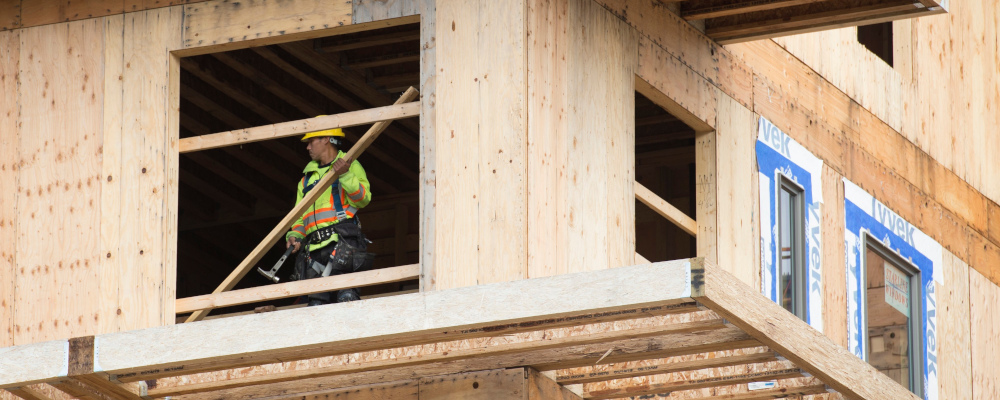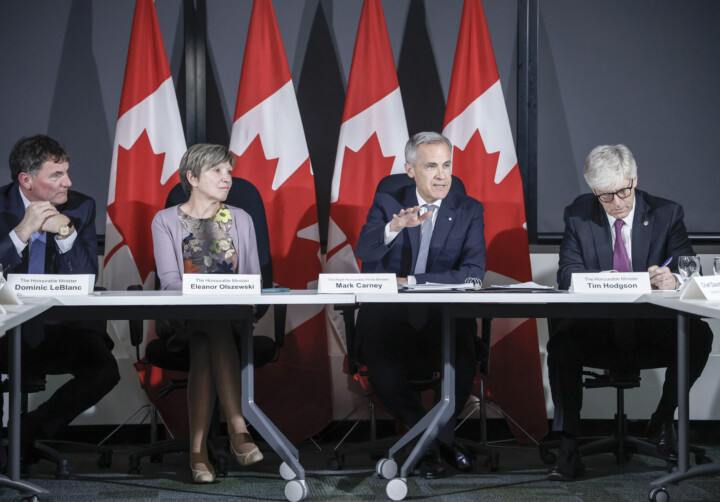Just over a week ago, the Trudeau government concluded its pre-budget consultations, a nationwide effort to hear from the public and gather big solutions to Canada’s biggest problems in the lead up to this year’s federal budget.
Of the various issues facing the country, the government’s consultation website rightly says “building more homes, faster” is one of this country’s “most pressing challenges.” To date, Ottawa has enacted a series of housing-related reforms, from removing the GST on rental apartment construction to signing dozens of deals with municipalities through the Housing Accelerator Fund. But by its own admission, there is more work to be done.
To be honest, when it comes to housing, the federal government faces a quandary in its upcoming budget. It needs to be bold with programs that can be implemented quickly and do not require high levels of state capacity, while at the same time ensuring that deficits and debts stay manageable and new spending does not “get in the [Bank of Canada’s] way of getting inflation back down.” Crafting public policy on housing that is simultaneously bold, fast, non-inflationary, and cheap is a daunting undertaking, but there are solutions out there that the government should consider.
So, we took the liberty here of giving them some ideas. Here is our submission.
Policies with unintended consequences
The obvious place to start is by removing policies that are hurting the construction of new housing supply. This would send a signal to investors that investment in new housing construction is welcome. Unfortunately, the federal government has engaged in several activities and made several statements that have caused a chilling effect on the sector. These need to be addressed.
One example is the yet-to-be-fulfilled promise in the Finance Minister’s 2021 mandate letter to consider “possible reforms to the tax treatment of Real Estate Investment Trusts (REITs), reviewing the down payment requirements for investment properties, and developing policies to curb excessive profits.” While residential REITs are consistently profitable (yielding approximately 3 percent), they are an efficient conduit for attracting investment; but fears of higher taxes deters investments and will send that capital elsewhere.
To single REITs out in particular for excessive profits is absurd, as anyone who invests through the Toronto Stock Exchange will quickly come to realize; a quick comparison of the five-year share price performance of the REIT sector relative to other sectors makes this abundantly clear. The government appears unlikely to fulfill this commitment anyway, so announcing that it will not be pursued (or revising the mandate letter to remove this language) would eliminate a great deal of uncertainty in the sector and help attract investment. It would also be zero fiscal cost to the federal treasury.
A second example is the federal government’s handling of new measures designed to prevent companies from deducting “excessive interest and financing expenses” for tax purposes (the “EIFEL” rules). These rules serve a very important purpose, namely, to prevent an offshore subsidiary in a tax haven from making large, high-interest loans and fees to companies operating in Canada as a way of shifting profits and lowering taxes paid in Canada. These measures are necessary and long overdue. However, in their design, the government inadvertently increased the taxes on companies that make large debt-financed capital investments on both sides of the U.S.-Canada border, such as apartment builders and utility companies. The U.S. wisely carved out an exemption for property developers and construction companies, and Canada should follow suit to avoid losing new rental housing investments to the United States.
Make it cheaper and easier to build
Of course, creating an attractive climate for investment is only beneficial if there are worthwhile projects in Canada to invest in. High interest rates and a challenging regulatory environment have made project economics challenging for both for-profit and not-for-profit developers alike, causing housing starts to fall for two consecutive years despite surging rents and robust population growth. The National Housing Accord created a blueprint to address these issues. While some of the recommendations, such as eliminating the GST on rental apartment construction, have been implemented, others still remain. Recommendations such as creating low-cost, long-duration fixed-rate financing for construction have no fiscal cost (so long as the rate charged is above the government’s cost of borrowing). In contrast, others, such as returning to 1960s-style tax treatment for apartment construction, have a relatively minor fiscal cost compared to the benefits.
Taxes, fees, and charges make up an estimated 31 percent of the purchase price of a new home in Ontario, so all levels of government should be examining how to reduce these costs while still paying for the vital infrastructure and programs that make for complete communities. High and rising land costs have also contributed to a lack of affordability. Our back-of-the-envelope estimates show the price of residential development land increased by nearly 1000 percent in London, Ontario over the last twenty years. This land cost escalation, coupled with municipal development charges that have increased from $5,000 to $47,000 for a single- or semi-detached home over this period has helped contribute to a lack of affordability.
Most of these increases were driven by factors outside of the federal government’s responsibilities, but they do have policy levers they can use to improve the situation. They could start by examining the root cause of land price escalation: scarcity coupled with a lack of competition. Municipal restrictions on building infill, coupled with a lack of greenfield land to support a growing population, led to speculation and hoarding of residential development land. Cities in Ontario need to have official plans that can support at least two decade’s worth of population growth. London Ontario’s Official Plan, ratified at the end of December 2016, was designed to support a population of 458,000 in 2035. But, it exceeded this figure by 2023, twelve years ahead of schedule. This means that 20 years of development land was exhausted in just eight, leading to shortages, speculation, hoarding, and sky-high land prices.
Land-use policies are municipal and provincial, but the federal government can help increase the supply of land to help drive affordability. Making federal land available is one important tool, though they can also use the Housing Accelerator Fund and other federal funding tools to drive needed changes at the municipal level. These changes should include legalizing density, including abolishing government-mandated parking minimums for all residential, commercial, and industrial properties, similar to Minnesota’s proposed “People Over Parking Act.” They could require cities to zone for density near high-frequency transit lines, like British Columbia’s recent reforms. Most critically, they could require municipalities to base their Official Plans on realistic forecasts of population growth provided by the federal government, with a built-in buffer if population growth is higher than forecast.

These reality-based forecasts would cause cities to upzone for greater density, institute more residential-development-friendly policies, and, in some cases, expand urban growth boundaries to allow for additional greenfield development. Cities must ensure that they have the necessary infrastructure to support infill development and that they are strategic in which lands they open to protect environmentally sensitive areas and areas prone to extreme weather events.
A question that often arises in any discussion of Canada’s housing supply gap is, “Who will build these homes?” Skills training and labour market and immigration reform can get us part of the way there, but we also need rapid productivity increases. Off-site manufacturing techniques, such as panelization and factory-built homes, can produce more homes with less labour. Unlike humans, robots can work 24 hours a day, seven days a week. An industrial strategy is needed to help grow the sector, which would include everything from regulatory reform to innovation policies.
The Canadian Home Builders’ Association’s proposal of a Housing Investment Tax Credit, similar to the Clean Technology Investment Tax Credit, is worth exploring to help innovative companies in the housing manufacturing sector scale up. Like returning to 1960s-style tax treatment, this tax credit would have a small but real financial cost. If the federal government were to implement such tax measures, they should make them time-limited, as they did with the removal of the GST on rental apartment construction. Time-limiting the incentives both encourages developers to move quickly but also lets the government control costs by allowing the measures to expire if they become too expensive relative to the benefits.
Address demand while waiting for supply
Canada’s housing crisis was largely caused by our housing stock not keeping up with population growth. Supply-side reforms are needed to increase the absorptive capacity of the housing system to support the newcomers that contribute so much culturally and economically to the fabric of this country. However, that will take time, so demand-side measures are needed while the country builds that capacity.
In the last 18 months, the number of non-permanent residents in Canada nearly doubled, from 1.37 million to 2.5 million. This rapid growth led to a crisis for international students and other non-permanent residents who did not have the housing or supports needed to thrive in Canada. The federal government has responded by capping international student visas, but there is more work to be done.
They could develop a plan to reduce the number of non-permanent residents to 2022 levels of roughly 1.5 million. This one-million-person reduction can happen through attrition by slowing the intake of non-permanent residents (as with the international student visa cap) to levels that are exceeded by the outflow. This includes those both leaving the country and those gaining permanent residency. The purpose of this would not be to close the border to those who contribute so much to Canada but rather give the country time to increase its absorptive capacity. This would then create the conditions for both newcomers and existing residents to thrive.
Recommended for You

The Alberta-Ottawa energy agreement sounds impressive—but how excited should we really be?

Canada just took one big step closer to reaching its energy superpower potential

International students jumped 400 percent at Canadian public colleges in last decade: Statistics Canada

‘We need transformation’: The Hunter Prize 2025 winners on the best ways to boost Canada’s economy and increase standards of living




